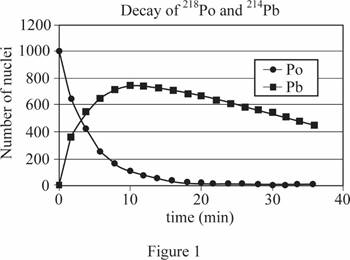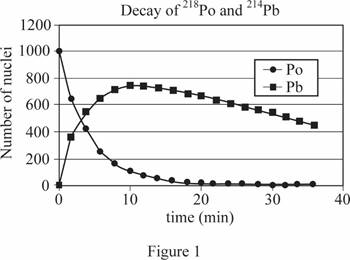
Concept explainers
(a)
The differential equation that defines the number of daughter nucleus.
(a)
Answer to Problem 20P
The daughter nucleus satisfies the differential equation is
Explanation of Solution
Let
Write the expression for decay rate
Here,
Write the expression for rate of change of the daughter nuclei
Here,
The rate of decay of the parent nucleus is same as the rate of production of the daughter nuclei.
Substitute
Conclusion:
Substitute
Thus, the daughter nucleus satisfies the differential equation is
(b)
The solution to the above differential equation using the verification by substitution method.
(b)
Answer to Problem 20P
Explanation of Solution
Write the expression for trail solution
Differentiate the above equation with respect to
Multiply equation (V) by
Write the expression for
Conclusion:
Solve (VII) further
Substitute (VIII) in the above equation and rearrange.
Thus,
(c)
The number of
(c)
Answer to Problem 20P
The number of

Explanation of Solution
Write the expression for decay constant
Here,
Substitute
Substitute
Substitute
Substitute
Conclusion:
Using expression (X) and (XI), table the number of
| 0 | 1000 | 0 |
| 2 | 445 | 350 |
| 4 | 408 | 557 |
| 6 | 261 | 673 |
| 8 | 167 | 730 |
| 10 | 107 | 752 |
| 12 | 68.3 | 751 |
| 14 | 43.7 | 737 |
| 16 | 27.9 | 715 |
| 18 | 17.9 | 689 |
| 20 | 11.4 | 660 |
| 22 | 7.30 | 631 |
| 24 | 4.67 | 602 |
| 26 | 2.99 | 573 |
| 28 | 1.91 | 545 |
| 30 | 1.22 | 519 |
| 32 | 0.781 | 493 |
| 34 | 0.499 | 468 |
| 36 | 0.319 | 445 |
Using the above data in the table construct the graph

Thus, the above graph shows the number of nuclei as a function of time.
(d)
The instant when the number of
(d)
Answer to Problem 20P
The number of
Explanation of Solution
From the above graph, the
(e)
An expression for maximum number of
(e)
Answer to Problem 20P
The time for maximum
Explanation of Solution
Equate (VI) to zero to find the maximum
Conclusion:
Simplify and rearrange for
Here,
Thus, time for maximum
(f)
The instant when the number of
(f)
Answer to Problem 20P
The time when the number of
Explanation of Solution
The time for maximum
Conclusion:
Substitute
Thus, the time when the number of
Want to see more full solutions like this?
Chapter 30 Solutions
Bundle: Principles of Physics: A Calculus-Based Text, 5th + WebAssign Printed Access Card for Serway/Jewett's Principles of Physics: A Calculus-Based Text, 5th Edition, Multi-Term
- 20. Two small conducting spheres are placed on top of insulating pads. The 3.7 × 10-10 C sphere is fixed whie the 3.0 × 107 C sphere, initially at rest, is free to move. The mass of each sphere is 0.09 kg. If the spheres are initially 0.10 m apart, how fast will the sphere be moving when they are 1.5 m apart?arrow_forwardpls help on allarrow_forwardpls help on thesearrow_forward
- pls help on all asked questions kindlyarrow_forwardpls help on all asked questions kindlyarrow_forward19. Mount Everest, Earth's highest mountain above sea level, has a peak of 8849 m above sea level. Assume that sea level defines the height of Earth's surface. (re = 6.38 × 106 m, ME = 5.98 × 1024 kg, G = 6.67 × 10 -11 Nm²/kg²) a. Calculate the strength of Earth's gravitational field at a point at the peak of Mount Everest. b. What is the ratio of the strength of Earth's gravitational field at a point 644416m below the surface of the Earth to a point at the top of Mount Everest? C. A tourist watching the sunrise on top of Mount Everest observes a satellite orbiting Earth at an altitude 3580 km above his position. Determine the speed of the satellite.arrow_forward
- pls help on allarrow_forwardpls help on allarrow_forward6. As the distance between two charges decreases, the magnitude of the electric potential energy of the two-charge system: a) Always increases b) Always decreases c) Increases if the charges have the same sign, decreases if they have the opposite signs d) Increases if the charges have the opposite sign, decreases if they have the same sign 7. To analyze the motion of an elastic collision between two charged particles we use conservation of & a) Energy, Velocity b) Momentum, Force c) Mass, Momentum d) Energy, Momentum e) Kinetic Energy, Potential Energyarrow_forward
 Modern PhysicsPhysicsISBN:9781111794378Author:Raymond A. Serway, Clement J. Moses, Curt A. MoyerPublisher:Cengage Learning
Modern PhysicsPhysicsISBN:9781111794378Author:Raymond A. Serway, Clement J. Moses, Curt A. MoyerPublisher:Cengage Learning Principles of Physics: A Calculus-Based TextPhysicsISBN:9781133104261Author:Raymond A. Serway, John W. JewettPublisher:Cengage Learning
Principles of Physics: A Calculus-Based TextPhysicsISBN:9781133104261Author:Raymond A. Serway, John W. JewettPublisher:Cengage Learning Physics for Scientists and Engineers with Modern ...PhysicsISBN:9781337553292Author:Raymond A. Serway, John W. JewettPublisher:Cengage Learning
Physics for Scientists and Engineers with Modern ...PhysicsISBN:9781337553292Author:Raymond A. Serway, John W. JewettPublisher:Cengage Learning University Physics Volume 3PhysicsISBN:9781938168185Author:William Moebs, Jeff SannyPublisher:OpenStax
University Physics Volume 3PhysicsISBN:9781938168185Author:William Moebs, Jeff SannyPublisher:OpenStax College PhysicsPhysicsISBN:9781285737027Author:Raymond A. Serway, Chris VuillePublisher:Cengage Learning
College PhysicsPhysicsISBN:9781285737027Author:Raymond A. Serway, Chris VuillePublisher:Cengage Learning College PhysicsPhysicsISBN:9781938168000Author:Paul Peter Urone, Roger HinrichsPublisher:OpenStax College
College PhysicsPhysicsISBN:9781938168000Author:Paul Peter Urone, Roger HinrichsPublisher:OpenStax College





